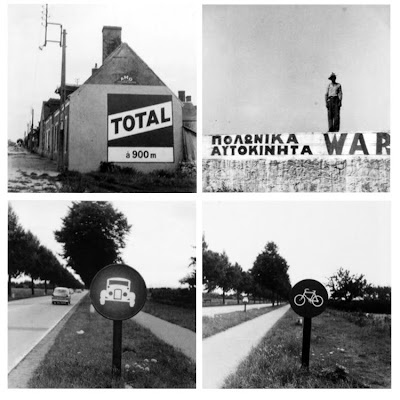(Ed Ruscha)
 Culture Black & White and Ed Ruscha Snapshots
Culture Black & White and Ed Ruscha Snapshots likes to remind "I grew up in a world uncolored " All movies, magazines, comicbooks who were fascinated by black and white.
The journey of seven months he made in 17 European countries with his mother and his brother opened the doors of photography, but rather as a way of documenting his future paintings. "Photography allows me to flat, two-dimensional reality, which then facilitates my inspiration for my paintings" . Moreover, these photos are essentially implemented the techniques he learned in school. His eye is walking distance but keeping true face movements, activity, few people, just things. Among the 450 reported no picture only shows the Eiffel Tower, Montmartre and the Acropolis, and does not attach to data subjects. They address only the curiosities and a "plastic" of ordinary scenes and isolated patterns, which creates a whole rather vernacular. He does not ever figure of notes on the place or date, confirming an anonymity that reflects the desire to capture details and impressions "I do not thinking I saw something that seemed to have vitality, and I the capture.

series, books, style
Not Returning from Europe, Ruscha began to sort and look at his pictures and changes its impulse to take photographs focusing on the series, while keeping the idea of a flattening of reality for future graphics. The first of these "products" for the everyday consumer goods, taken as a state, that is to say, used, damaged, lost and found, the readymade. Approach still passive, but this time local, by which it continues to be a kind of memory.
Gradually he began new series, and developed his passion for books, "for the finished pieces to the tactile sensations" . He published 17 books in 16 years each dedicated to a series. Books materialize gradually these inspirations, and allow it to refine it as and when the idea of objectivity and refusal of any style or look to the subject being photographed. He thus established a frame for each, where the images arising on a predefined grid, looking for a strict neutrality and clarity. And no style is gradually becoming a style that archive now works in paper.

gasoline stations 26 & 34 parking lots
"I had the vision to be a reporter when I did a series on petrol stations. I was Oklahoma's return to Los Angeles five or six times a year, and I saw all these areas fallow telling me that someone would surely bring in their new city. Take petrol stations, unique landmark in the desert landscapes, still in the same way, was for me the most direct way to bring this news, the easiest way to take the facts. It was just a manual, as an instruction manual, for people who wanted to know more about things like that .
All stations have the same composition, dictated by the same structure function: garage, shop, pool and overlooking a brand, a logo. What interests Ruscha, besides the kinematic effect snapashot itself (it runs, it stops, it always takes the same picture, he goes) it's the little details that emerge then, signs that companies put in place to allow their client to identify. By this repetitive action, which permeates his entire approach, this neutrality that seeks and explores it through different frames (photographic recording technique, grids of these books, functional structures like buildings) it highlights the differences, details, and exalts them, while remaining disengaged.
 The conceptual work will take an even more abstract with the series 34 parking lots in Los Angeles. One Sunday morning when the car parks are empty, he rented a helicopter and a professional photographer and over the city for an hour and a half, giving instructions to photographers taking pictures for him.
The conceptual work will take an even more abstract with the series 34 parking lots in Los Angeles. One Sunday morning when the car parks are empty, he rented a helicopter and a professional photographer and over the city for an hour and a half, giving instructions to photographers taking pictures for him. These aerial photographs to create a funnel vision, and depth of field that can not be measured or defined. In these particular images, taken from above from a relatively low altitude, the view does not generate the illusion of spatial depth, but rather suggests a flat slope on a diagonal. Looking back on the first photographs of Ruscha, including this view of Venice taken in 1961, then we feel with those pictures of car parks which these aspirations were already present, but in an uncontrolled state. What makes this work with air, with the conceptual baggage that it has implemented, is that the extension of research started intuitively 8 years earlier and which continues, a flattening of reality, the play of diagonals and perspectives, and the slow and meticulous streamlining these impressions.
 and bonus on the Sunset Strip, a folder of 9 meters long and which are photographed every building on Sunset Strip in Los Angeles
and bonus on the Sunset Strip, a folder of 9 meters long and which are photographed every building on Sunset Strip in Los Angeles 


Book. Photographer Ed Ruscha
, Whitney Steidl Publishing, 2006
Video. Ed Ruscha
talks about his work here
Tracks.
The Doors, LA Woman, there
0 comments:
Post a Comment